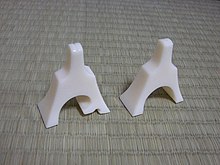184:
25:
241:, are often made of plastic in the modern day, and can be found in both small and large sizes. These bridges are rearranged as needed during playing, and are arranged according to the particular tuning used. Strings are traditionally made from
208:, but with reinforced design elements; for instance, the platform where strings are tied runs the entire length and breadth of the instrument to accommodate the increased strain.
310:
108:
202:
was largely hand-constructed, as only limited machinery existed to manufacture it. It was built along similar lines to the common
42:
89:
46:
61:
259:
is not widely used. There are few extant examples of the instrument today, as it never achieved the popularity of the
68:
35:
156:
75:
57:
315:
305:
219:
280:
Jinko, Katsamura (1986). "Some
Innovations in Musical Instruments in Japan during the 1920s".
146:
82:
260:
299:
166:
150:
245:
threads, although plastic nylon strings are often used as a cheaper alternative.
24:
183:
153:
created in 1923. Miyagi added 67 strings to the traditional 13-string
182:
242:
162:
175:. It is widely seen as a short-lived experimental instrument.
18:
288:. International Council For Traditional Music: 157–172.
229:
in
Japanese) is molded and treated. The bridges of the
254:
236:
230:
224:
212:
203:
197:
187:
170:
154:
124:
217:, the Paulownia wood used for the instruments' body (
161:design, creating an instrument much like a western
49:. Unsourced material may be challenged and removed.
165:. Together, the 80 strings provide a far larger
131:
16:80-stringed variant of the Japanese koto zither
138:
8:
263:, Miyagi's more widely accepted invention.
109:Learn how and when to remove this message
149:, was an invention of Japanese composer
272:
7:
47:adding citations to reliable sources
14:
23:
34:needs additional citations for
282:Yearbook for Traditional Music
1:
311:Japanese musical instruments
255:
237:
231:
225:
213:
204:
198:
188:
171:
155:
132:
125:
332:
139:
169:range than the standard
193:
186:
43:improve this article
220:Paulownia tomentosa
194:
119:
118:
111:
93:
323:
290:
289:
277:
258:
240:
234:
228:
216:
207:
201:
191:
174:
160:
144:
142:
141:
135:
128:
114:
107:
103:
100:
94:
92:
58:"80-string koto"
51:
27:
19:
331:
330:
326:
325:
324:
322:
321:
320:
296:
295:
294:
293:
279:
278:
274:
269:
251:
181:
136:
130:, known as the
115:
104:
98:
95:
52:
50:
40:
28:
17:
12:
11:
5:
329:
327:
319:
318:
313:
308:
298:
297:
292:
291:
271:
270:
268:
265:
261:17-string koto
253:The 80-string
250:
247:
211:As with other
196:The 80-string
180:
177:
117:
116:
31:
29:
22:
15:
13:
10:
9:
6:
4:
3:
2:
328:
317:
314:
312:
309:
307:
304:
303:
301:
287:
283:
276:
273:
266:
264:
262:
257:
248:
246:
244:
239:
233:
227:
222:
221:
215:
209:
206:
200:
190:
185:
178:
176:
173:
168:
164:
159:
158:
152:
151:Michio Miyagi
148:
134:
129:
127:
113:
110:
102:
91:
88:
84:
81:
77:
74:
70:
67:
63:
60: –
59:
55:
54:Find sources:
48:
44:
38:
37:
32:This article
30:
26:
21:
20:
316:Koto players
306:Tube zithers
285:
281:
275:
252:
218:
210:
195:
179:Construction
122:
120:
105:
96:
86:
79:
72:
65:
53:
41:Please help
36:verification
33:
235:, known as
223:, known as
140:八十絃/はちじゅうげん
300:Categories
267:References
133:hachijugen
123:80-string
99:March 2023
69:newspapers
284:(Print).
192:(bridges)
147:Japanese
83:scholar
85:
78:
71:
64:
56:
249:Usage
167:pitch
90:JSTOR
76:books
256:koto
243:silk
232:koto
226:kiri
214:koto
205:koto
199:koto
172:koto
163:harp
157:koto
126:koto
121:The
62:news
238:jii
189:Jii
145:in
45:by
302::
286:18
143:)
137:(
112:)
106:(
101:)
97:(
87:·
80:·
73:·
66:·
39:.
Text is available under the Creative Commons Attribution-ShareAlike License. Additional terms may apply.
